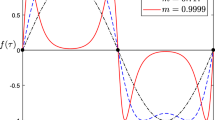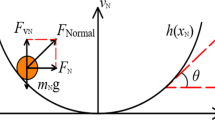Abstract
This paper develops a design method for the interconnections of a network of Andronov–Hopf oscillators such that the system exhibits a desired strange attractor. Because of the structure of the oscillators, the desired behavior can be achieved via weak linear coupling, which destabilizes the oscillators’ phase difference. First, a set of sufficient conditions are established that result in phase destabilization, and thus instability, of a desired periodic solution. Then, an additional condition is determined to ensure that all harmonic periodic orbits will be unstable. Finally, additional numerical properties are assessed, where tuning of a small parameter can result in chaos.



Similar content being viewed by others
References
Stergiou, N., Decker, L.M.: Human movement variability, nonlinear dynamics, and pathology: Is there a connection? Hum. Mov. Sci. 30(5), 869 (2011)
Rabinovich, M., Abarbanel, H.: The role of chaos in neural systems. Neuroscience 87(1), 5 (1998)
Buzzi, U.H., Stergiou, N., Kurz, M.J., Hageman, P.A., Heidel, J.: Nonlinear dynamics indicates aging affects variability during gait. Clin. Biomech. 18(5), 435 (2003)
Cignetti, F., Schena, F., Rouard, A.: Effects of fatigue on inter-cycle variability in cross-country skiing. J. Biomech. 42(10), 1452 (2009)
Kurz, M.J., Stergiou, N.: An artificial neural network that utilizes hip joint actuations to control bifurcations and chaos in a passive dynamic bipedal walking model. Biol. Cybern. 93(3), 213 (2005)
Mandell, A.J., Selz, K.A.: Brain stem neuronal noise and neocortical “resonance”. J. Stat. Phys. 70(1–2), 355 (1993)
Shinbrot, T., Grebogi, C., Yorke, J.A., Ott, E.: Using small perturbations to control chaos. Nature 363(6428), 411 (1993)
Chen, G., Lai, D.: Anticontrol of chaos via feedback. In: Proceedings of the 36th IEEE Conference on Decision and Control, 1997, vol. 1, pp. 367–372. IEEE (1997)
Chen, G., Lai, D.: Feedback anticontrol of discrete chaos. Int. J. Bifurc. Chaos 8(07), 1585 (1998)
Yang, L., Liu, Z., Chen, G.: Chaotifying a continuous-time system via impulsive input. Int. J. Bifurc. Chaos 12(05), 1121 (2002)
Morgül, Ö.: A model-based scheme for anticontrol of some chaotic systems. Int. J. Bifurc. Chaos 13(11), 3449 (2003)
Popovych, O.V., Maistrenko, Y.L., Tass, P.A.: Phase chaos in coupled oscillators. Phys. Rev. E 71(6), 065201 (2005)
Li, X., Chen, G.: Synchronization and desynchronization of complex dynamical networks: an engineering viewpoint. IEEE Trans. Circuits Syst. I: Fundam. Theory Appl. 50(11), 1381 (2003)
Kiss, I.Z., Rusin, C.G., Kori, H., Hudson, J.L.: Engineering complex dynamical structures: sequential patterns and desynchronization. Science 316(5833), 1886 (2007)
Wang, X.F., Chen, G., Yu, X.: Anticontrol of chaos in continuous-time systems via time-delay feedback. Chaos: Interdiscip. J. Nonlinear Sci. 10(4), 771 (2000)
Yu, S., Chen, G.: Anti-control of continuous-time dynamical systems. Commun. Nonlinear Sci. Numer. Simul. 17(6), 2617 (2012)
Kuramoto, Y.: Chemical Oscillations, Waves, and Turbulence, vol. 19. Springer, Berlin (2012)
Tukhlina, N., Rosenblum, M., Pikovsky, A., Kurths, J.: Feedback suppression of neural synchrony by vanishing stimulation. Phys. Rev. E 75(1), 011918 (2007)
Kohannim, S.: Optimal oscillations and chaos generation in biologically-inspired systems. Ph.D. thesis, UCLA (2016)
Russell, D.A., Hanson, J.D., Ott, E.: Dimension of strange attractors. Phys. Rev. Lett. 45(14), 1175 (1980)
Farmer, J.D., Ott, E., Yorke, J.A.: In: The Theory of Chaotic Attractors, pp. 142–169. Springer (1983)
Fradkov, A.L., Evans, R.J.: Control of chaos: methods and applications in engineering. Annu. Rev. Control 29(1), 33 (2005)
Fradkov, A.L., Yakubovich, V.A.: The S-procedure and duality relations in nonconvex problems of quadratic programming. Vestn. LGU Ser. Mat. Mekh. Astron. 6, 101 (1979)
Moon, F.C.: Chaotic and Fractal Dynamics: Introduction for Applied Scientists and Engineers. Wiley, Hoboken (2008)
Hodgkin, A., Huxley, A.: A quantitative description of membrane currents and its application to conduction and excitation in nerve. J. Physiol. 117(4), 500 (1952)
Acknowledgements
This research was supported by the National Science Foundation (NSF) Graduate Research Fellowship under Grant No. DGE-1144087.
Author information
Authors and Affiliations
Corresponding author
Ethics declarations
Conflict of interest
The authors declare that they have no conflict of interest.
Additional information
Publisher's Note
Springer Nature remains neutral with regard to jurisdictional claims in published maps and institutional affiliations.
Appendix
Appendix
1.1 Proof of Lemma 1
Proof
Consider the following coordinate transformation \((q, p)\leftrightarrow (r,\theta )\), defined by
With the new state variables \((r,\theta )\), system (3) with coupling (5) can be expressed as
where \(R:=\text {diag}(r)\). Let x(t), \(t\ge 0\), be an arbitrary trajectory starting at a point in \({\mathbb {S}}_\delta \). Suppose x(t) hits the boundary of \({\mathbb {S}}_\delta \) at \(t=t_1 \ge 0\) for the first time. Then, there exists a subset of \({\mathbb {I}}_n\), denoted by \({\mathbb {I}}_{\mathrm{hit}}\), such that \(r_k(t_1)^2=1+\delta \) or \(r_k(t_1)^2=1-\delta \) for \(k\in {\mathbb {I}}_{\mathrm{hit}}\), while \(|r_i(t_1)^2-1|<\delta \) for \(i\in {\mathbb {I}}_n\backslash {\mathbb {I}}_{\mathrm{hit}}\). When \(r_k(t_1)^2=1+\delta \), using (19), the derivative of \(r_k(t)^2/2\) at \(t=t_1\) is given by
for some vector \(\alpha \in {\mathbb {R}}^n\) dependent on H and \(\theta (t_1)\). Since \(|r_k\alpha ^{\mathsf{\mathrm{T}}}r|\) is bounded by a number that depends only on H and \(\delta \), the second term can be made smaller in magnitude than the first term by a choice of \({\varepsilon }\). Thus, the derivative is negative, and \(r_k^2\) decreases from \(1+\delta \). By a similar argument, we see that the value of \(r_k^2\) increases when \(r_k(t_1)^2=1-\delta \). Hence, x cannot go across the boundary of \({\mathbb {S}}_\delta \), proving the invariance.
To show that \({\mathbb {S}}_\delta \) is locally attractive, suppose x(t) is outside, but not too far from, the boundary of \({\mathbb {S}}_\delta \). That is, there exist \(\rho \in {\mathbb {R}}\) and a subset of \({\mathbb {I}}_n\), denoted by \({\mathbb {I}}_{\mathrm{out}}\), such that \(\delta \le |r_k(t)^2-1|<\rho <1/2\) for \(k\in {\mathbb {I}}_{\mathrm{out}}\). The derivative of \(r_k(t)^2/2\) is then bounded by
Following a similar argument as before, for a small enough choice of \({\varepsilon }\), the bound on the derivative is sign definite until \(r_k(t)\) hits the boundary of \({\mathbb {S}}_\delta \) to take value \(1+\delta \) or \(1-\delta \). Thus, x will enter \({\mathbb {S}}_\delta \). \(\square \)
1.2 Proof of Lemma 2
Proof
First, note from (8) that
Based on matrix norm properties, the following inequalities hold:
where \(\Vert \cdot \Vert _F\) is the Frobenius norm, and \(\varsigma \) is a constant defined such that \(||P(t)||<1/\varsigma \) for all \(t\ge 0\). Let \(\tilde{\mu }_\delta \triangleq \tilde{\mu }-\delta \) for sufficiently small \(\delta >0\). Then,
Since \(\tilde{\mu }_\delta \) can make the left-hand side go to infinity, we conclude that \(\lambda \ge \tilde{\mu }\). \(\square \)
1.3 Proof of Lemma 5
Proof
By Lemma 4, all possible harmonic solutions have the form (14). Substituting \(\xi (t)\) into (3) gives

where  and \(\varGamma \) denote diagonal matrices of \(\omega \) and \(\gamma \), respectively. Noting that
and \(\varGamma \) denote diagonal matrices of \(\omega \) and \(\gamma \), respectively. Noting that
we see that \(\xi (t)\) is a solution of the dynamical system if and only if

This equation is further equivalent to

where we noted that  and \(\varOmega _\varphi \) commute. The structure of H in (12) implies \({{\bar{H}}}_{11}={{\bar{H}}}_{22}\) and \({{\bar{H}}}_{12}=-{{\bar{H}}}_{21}\), and hence, the second and fourth equalities are satisfied. The first equality is expressed as
and \(\varOmega _\varphi \) commute. The structure of H in (12) implies \({{\bar{H}}}_{11}={{\bar{H}}}_{22}\) and \({{\bar{H}}}_{12}=-{{\bar{H}}}_{21}\), and hence, the second and fourth equalities are satisfied. The first equality is expressed as
Clearly, \(\gamma _i\) satisfying this condition for a small \(|{\varepsilon }|\) has to be close to 1, \(-1\), or 0. All the harmonic solutions near  can be captured by those near
can be captured by those near  due to the freedom in \(\varphi \). By the implicit function theorem, \(\eta ({\varepsilon },\gamma )=0\) is solvable for \(\gamma \) when \(|{\varepsilon }|\) is sufficiently small since
due to the freedom in \(\varphi \). By the implicit function theorem, \(\eta ({\varepsilon },\gamma )=0\) is solvable for \(\gamma \) when \(|{\varepsilon }|\) is sufficiently small since  and
and  hold. In particular, the solution in the neighborhood of
hold. In particular, the solution in the neighborhood of  is expressed as \(\gamma =g({\varepsilon })\) for a continuously differentiable function g such that
is expressed as \(\gamma =g({\varepsilon })\) for a continuously differentiable function g such that  , and the derivative is given by
, and the derivative is given by

The formula for \(\gamma \) now follows as the Taylor series and that for \(\omega \) is then obtained by solving the third equality. \(\square \)
Rights and permissions
About this article
Cite this article
Kohannim, S., Iwasaki, T. Design of coupled Andronov–Hopf oscillators with desired strange attractors. Nonlinear Dyn 100, 1659–1672 (2020). https://doi.org/10.1007/s11071-020-05547-0
Received:
Accepted:
Published:
Issue Date:
DOI: https://doi.org/10.1007/s11071-020-05547-0




